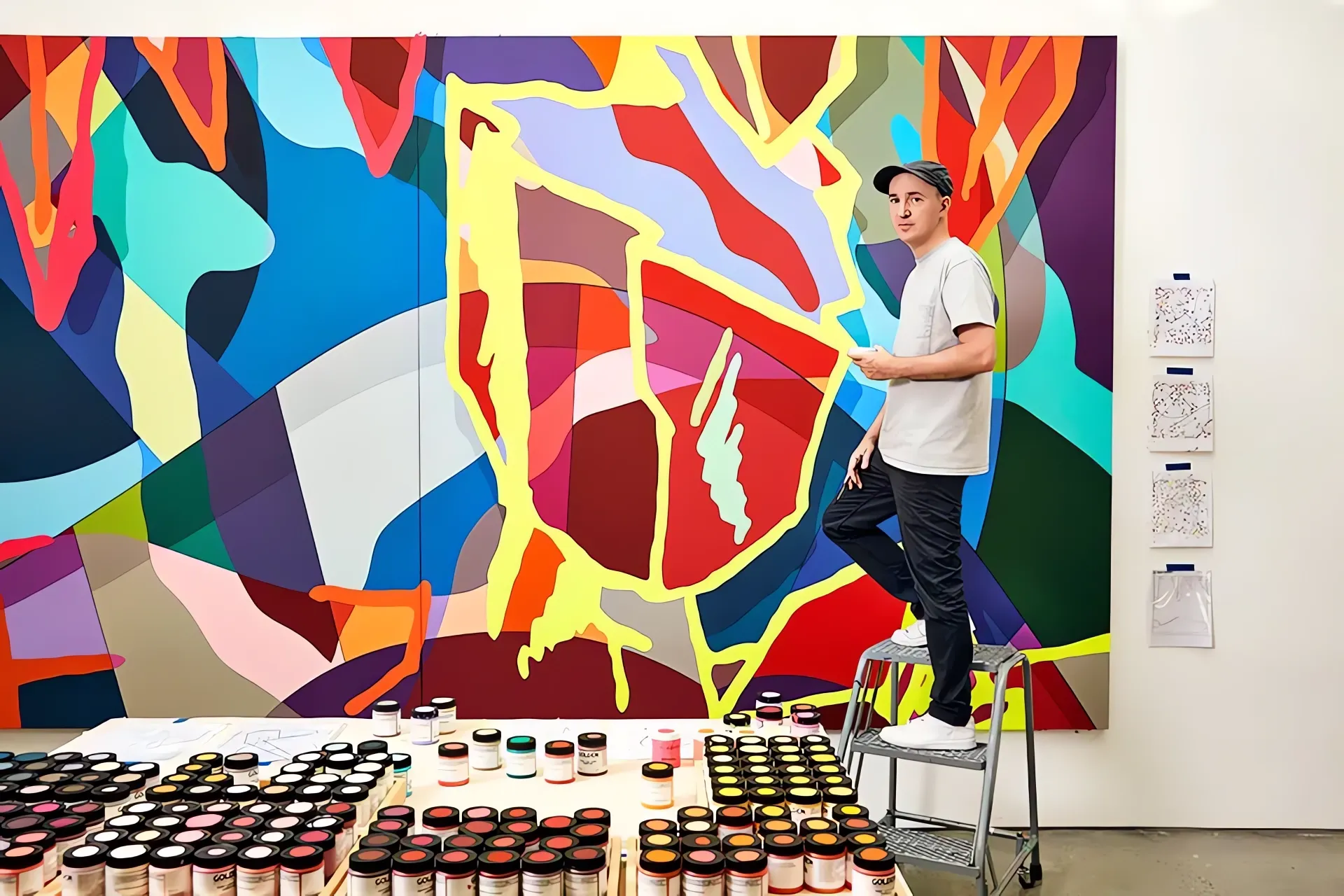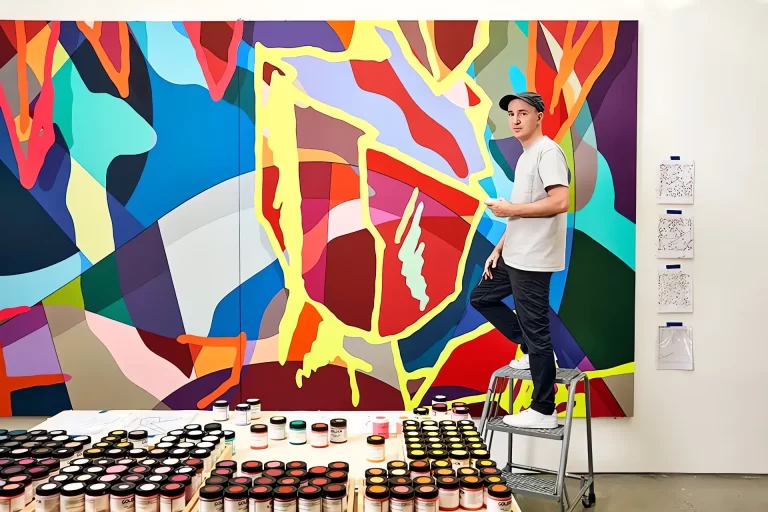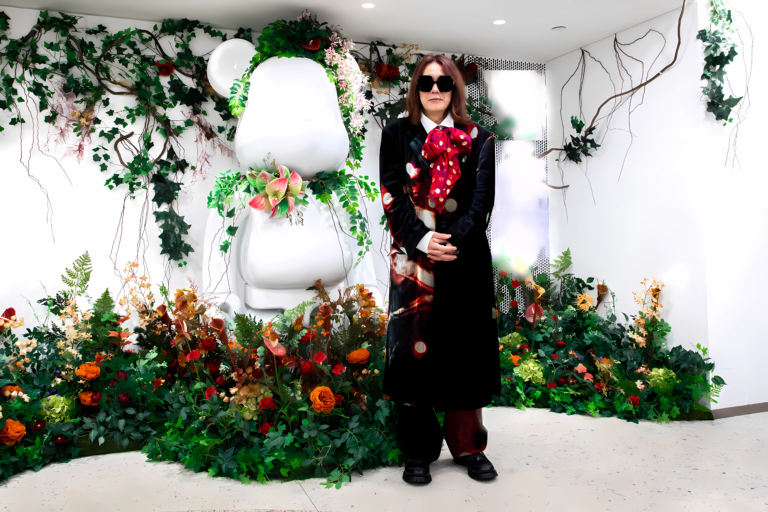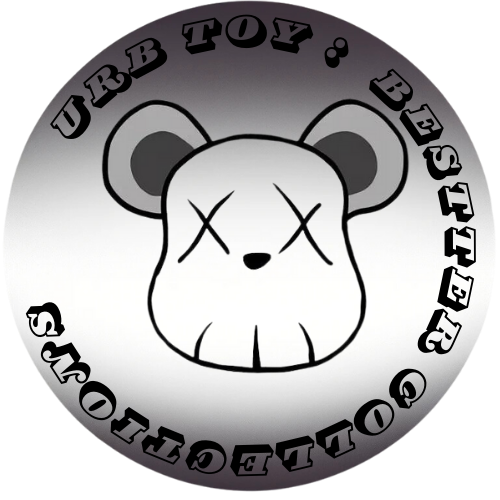Introduction: Unveiling KAWS (Brian Donnelly)
Renowned globally, the artist known as KAWS was born Brian Donnelly in 1974, New Jersey, USA. Today, he stands as one of the most influential modern artists, his works traversing contemporary art, product design, paintings, murals, large sculptures, and toys. Yet, the moniker KAWS wasn’t Brian’s first choice, revealing the latter with a playful retort, “That’s my business.” His journey from an art enthusiast to a celebrated artist unveils a story rich with passion, persistence, and the unyielding urge to resonate through creativity.
Early Life and Discovery of Artistic Passion
KAWS’s early influences were as unexpected as they were diverse. Unlike many budding artists who seek inspiration from revered masters and renowned art institutions, KAWS was drawn towards the vibrant and gritty subcultures of skateboarding and graffiti that thrived in the urban landscapes of New York City. These subcultures not only resonated with his artistic inklings but also defined his unique artistic identity, setting him on a trajectory that defied convention.
In the 1990s, armed with a can of spray paint, KAWS embarked on his artistic journey, marking the city streets with his unique style. It was during this period that he adopted the moniker “KAWS,” a name that would soon become synonymous with innovation and creativity in the world of street art. His graffiti work, characterized by bold lines and a distinctive skull-and-crossbones motif, soon caught the attention of fellow artists and curious passersby alike.
What set KAWS apart during his early foray into street art was not just his technical skill, but also his ability to infuse his pieces with a sense of irreverence and subversion. He challenged the conventions of mainstream art with his provocative, often satirical, take on pop culture icons. This irreverent streak, combined with an innate talent for storytelling through visuals, laid the foundation for his transition from a street art rebel to a groundbreaking artist.
As KAWS honed his craft on the streets of New York, his work began to evolve beyond traditional graffiti. He introduced a cast of characters, including the instantly recognizable “Companion,” a Mickey Mouse-like figure with X’s for eyes. These characters would go on to become the cornerstone of his artistic expression, bridging the gap between the world of street art and fine art.
In a world where conformity often stifles creativity, KAWS’s early life experiences and influences served as catalysts for innovation. His journey from Jersey City to the global art stage is a testament to the transformative power of art born from unconventional roots. It’s a reminder that the most extraordinary stories often emerge from the most unexpected beginnings.
His early life unfolded a rich tapestry of experiences and influences that played a monumental role in shaping his remarkable journey through the world of contemporary art. The blend of middle-class values instilled during his upbringing, combined with an innate curiosity and an unyielding passion for art, propelled KAWS to a global artistic prominence that continues to resonate in the contemporary art scene.
The Origin of the Name ‘KAWS’
The inception of the pseudonym “KAWS” is intertwined with the artistic persona that Brian Donnelly would come to embody. As a young, aspiring artist, the necessity of a pseudonym that resonated with his artistic inklings became apparent. The moniker wasn’t just a name; it was an identity, a voice that would speak through vibrant colors and evocative imagery on urban canvases.
The name ‘KAWS’ didn’t dawn upon Brian in a moment of sudden revelation, but rather, it was a meticulous choice, embodying the visual and philosophical ethos he aimed to project in his art. During his high school years, when his creative energies began earnestly interacting with the world, the idea of a pseudonym started taking a concrete shape. The letters K, A, W, and S weren’t just alphabets; they were visual elements, each with its own geometric aesthetics and phonetic rhythm. When combined, they resonated a visual and auditory aesthetic that appealed to Brian’s artistic sensibilities.
The choice of a pseudonym is often a profound decision for an artist. It’s not merely a label, but an alter ego, an avatar that interacts with the world, carrying the essence of the artist’s vision, beliefs, and aspirations. For Brian Donnelly, ‘KAWS’ became a reflection of his evolving artistic ethos. It was a name that would go on to challenge the conventional boundaries between fine art and street art, between the elite galleries and the rebellious streets.
The pseudonym ‘KAWS’ also reflected a sense of universality and accessibility, attributes that were deeply ingrained in Brian’s artistic philosophy. He believed in art as a medium of dialogue, a bridge between the artist and the audience, irrespective of their background or artistic literacy. The simplicity and memorability of the name ‘KAWS’ facilitated this dialogue, making his art more approachable and relatable to a broader audience.
Over the years, ‘KAWS’ has transcended the persona of Brian Donnelly and has become a legacy, a monumental name in the world of contemporary art. It’s not just a name; it’s a movement, a philosophy, a unique lens through which the world is perceived and portrayed.
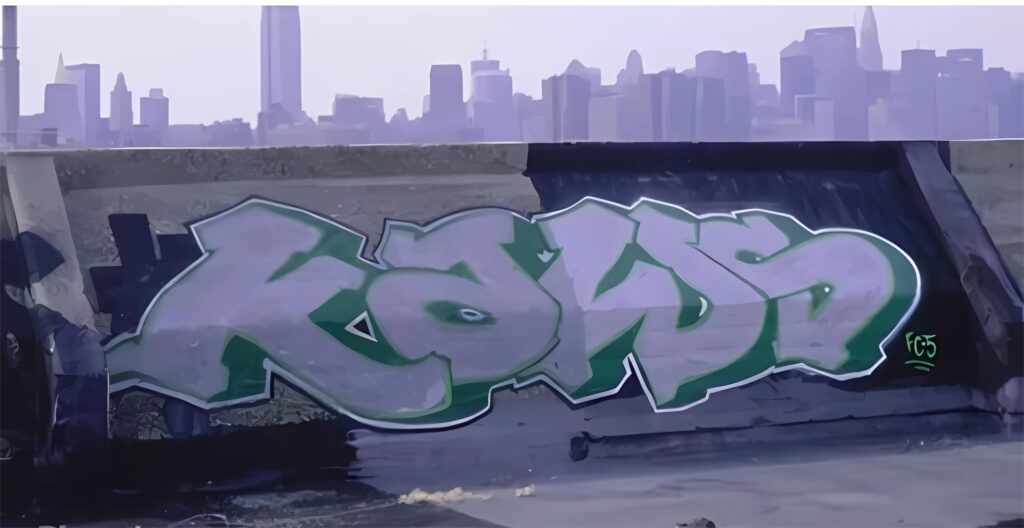
Stepping into Professional World: From Streets to Disney
The transition from street artistry to the professional realm marked a significant chapter in KAWS’s artistic journey. Post his education at the School of Visual Arts in New York, KAWS embarked on a professional venture by joining Jumbo Pictures, which was later acquired by Disney. This stint was an unexpected turn, drawing him into the meticulous world of animation, a contrast to the free-spirited expression he was accustomed to on city streets.
At Disney, KAWS worked on projects like “101 Dalmatians”, “Daria”, and “Doug”, gaining insights into the narrative and visual potential of animation. This professional engagement, however, didn’t sway KAWS from his street art roots. Instead, it enriched his artistic lexicon, providing a juxtaposition of structured creativity against the unrestrained spirit of street art.
The dichotomy between the disciplined environment at Disney and the freedom of street artistry significantly influenced KAWS’s subsequent work. It blended the spontaneous essence of street art with a newfound appreciation for narrative storytelling garnered from animation.
The chapter at Disney was a fusion of contrasting experiences, contributing to the evolving narrative of KAWS’s artistic persona. It was a journey from spray cans to animation studios, yet the core essence of rebellious creativity remained intact, steering KAWS towards a unique artistic trajectory that defies conventional categorization.
Street Art and Graffiti: A Lifelong Affection
The realm of street art and graffiti is inherently transient, yet it carries an indelible imprint of time, place, and social discourse. For KAWS, it was a medium through which he could engage in a direct dialogue with the urban environment and its denizens. It was this unfiltered interaction that nurtured his affinity for street culture, embedding a sense of authenticity and immediacy in his work.
As his artistic prowess matured, so did his interpretation of street art. What began as a form of self-expression morphed into a potent medium for social commentary and cultural critique. The rough textures of urban walls, the fleeting nature of graffiti, and the immediate feedback from the onlookers, all contributed to shaping KAWS’s narrative style.
His early works were an ode to the rebellious spirit of street culture, often reflecting the socio-political milieu of the time. However, as he navigated through the realms of mainstream art, KAWS didn’t abandon his street art roots. Instead, he integrated the gritty aesthetics and spontaneous creativity of street art with more refined, conceptual frameworks.
The symbiotic relationship between KAWS and street art transcends the physical act of painting on walls. It reflects a deeper, philosophical engagement with the public space and the shared human experience. His large-scale sculptures and installations, although now situated in galleries and open spaces, still echo the ethos of street art – challenging conventions, provoking thought, and inviting public engagement.
Moreover, his iconic characters, especially the “Companion,” embody the essence of street art. They are relatable, evocative, and carry the whimsical charm of street culture, bridging the gap between the elitist perceptions of art and the more accessible, democratic nature of street art.
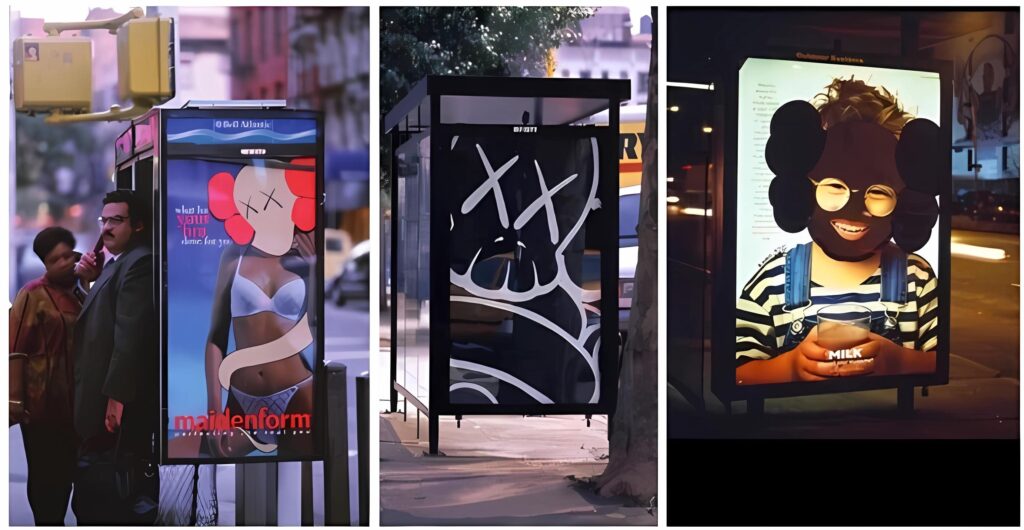
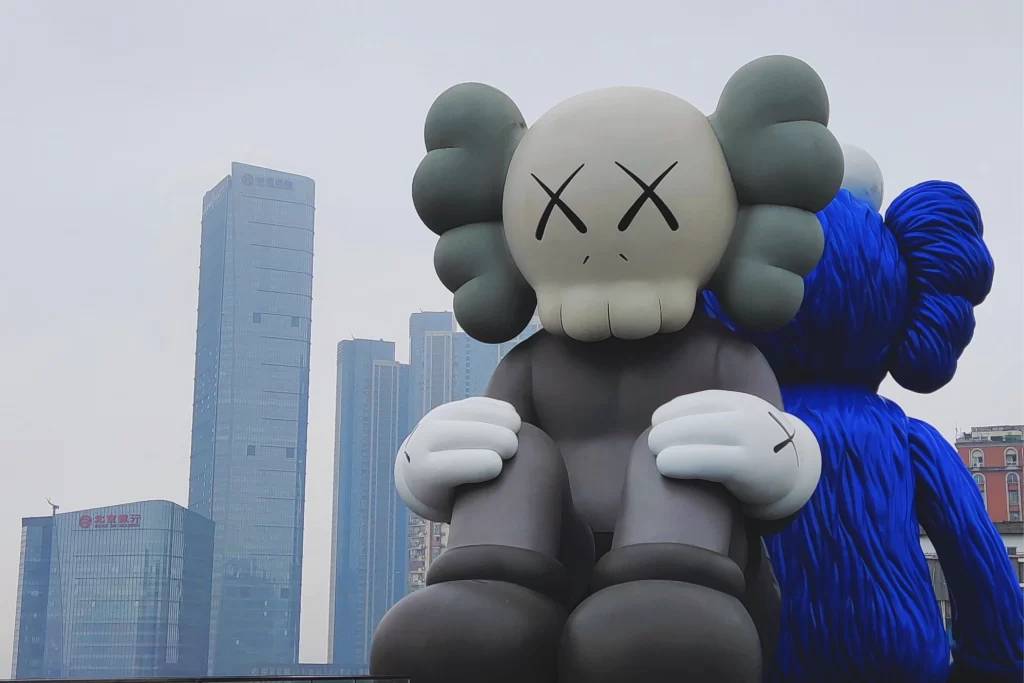
Transition to Mainstream Art: Murals, Sculptures, and Beyond
The journey of KAWS from a street artist to a heralded figure in mainstream contemporary art is a tale of perpetual exploration, innovation, and adept fusion of varied artistic spheres. This transition was neither abrupt nor straightforward; it was a gradual synthesis of his street art essence with the broad vistas that mainstream art unfolded.
One of the hallmark endeavours that spotlighted KAWS’s seamless transition into mainstream was his early work on public bus stop advertisements. His audacious alterations of advertising billboards were not only a bold statement of his street art ethos but also a critique of consumerism. This venture was a precursor to the more structured, yet equally evocative work that would follow in mainstream art spaces.
As KAWS immersed himself in mainstream art, murals became a significant medium. These large-scale canvases allowed him to retain the grandiosity and public engagement inherent to street art, whilst introducing a more polished, conceptual approach. His murals transcended being mere enlargements of his street artworks; they were complex narratives delivered with a finesse that bore witness to his burgeoning mastery over a diverse array of artistic techniques.
Simultaneously, KAWS ventured into the domain of sculptures, a stride that notably broadened his artistic panorama. The three-dimensional realm enabled him to render his ideas in a tangible, tactile manner. His sculptures, often monumental in scale, mirrored the street art spirit in their bold, evocative imagery, yet were marked by refined aesthetics and thematic profundity. The iconic “Companion” sculpture series epitomizes KAWS’s prowess in navigating both the street and mainstream contemporary art realms, offering narratives that are poignant yet accessible to a wide audience.
Furthermore, KAWS’s excursion into commercial collaborations and product design was a testament to his ability to transcend conventional artistic boundaries. His collaborations with globally renowned brands created a nexus of art, fashion, and pop culture, rendering contemporary art more accessible and resonant with a broader demographic.
Beyond murals and sculptures, KAWS’s explorations continued to burgeon, each venture marking a stride deeper into mainstream contemporary art’s heart, albeit without forsaking his street art roots. His exhibitions across prestigious global galleries underscore his established stance in the contemporary art milieu, yet the rebellious spirit, the relentless quest to challenge art’s conventional notions, remains untouched.
Conclusion: The Enigmatic Essence of KAWS
The allure of KAWS lies in his capability to engage a diverse audience, to provoke thought, and to challenge conventional boundaries of what art can represent and how it can interact with society. His work is a dialogue, an ongoing conversation not just between the artist and the audience, but among the audience themselves, provoking a discourse that transcends the visual spectacle.
The journey of KAWS is a testament to the potential of art to both reflect and shape societal dynamics. His work is a mirror, reflecting the zeitgeist, yet it’s also a window into alternative perspectives, inviting viewers to explore the layered narratives embedded within. The duality of his work, where whimsical characters meet profound themes, where street aesthetics meld with polished finesse, encapsulates the evolving narrative of contemporary art.
His indelible mark on both street and mainstream art showcases the fluidity of artistic expression, the potential to evolve, adapt, and transcend traditional categorizations. The street-savvy rebel who once commandeered public spaces with audacious graffiti has morphed into a global art icon, yet the essence of rebellion, the voice that seeks to challenge, to question, remains intact.
Furthermore, the commercial collaborations and widespread recognition KAWS has garnered didn’t dilute his artistic ethos but rather amplified his message, broadening the reach and impact of his work. His ability to maintain a nuanced balance between commercial success and artistic integrity is a hallmark of his enduring relevance in the dynamic contemporary art landscape.
In retrospect, the enigmatic essence of KAWS is a narrative of aspiration, a story that inspires artists and aficionados alike to explore beyond the conventional, to engage with art in a manner that is both personal and collective. It’s a reminder of the transformative power of art, its ability to challenge the status quo, engage diverse communities, and foster a dialogue that extends beyond the canvas.

